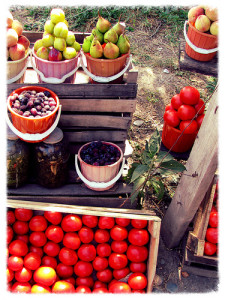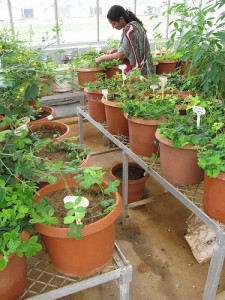 Never rains but it pours. There’s another conference looking for abstracts: it’s the II International Symposium on Wild Relatives of Subtropical and Temperate Fruit and Nut Crops. It will be held April 7-12, 2014 in Baku, Azerbaijan in the conference hall of the Genetic Resources Institute of the National Academy of Sciences, in cooperation with the ISHS.
Never rains but it pours. There’s another conference looking for abstracts: it’s the II International Symposium on Wild Relatives of Subtropical and Temperate Fruit and Nut Crops. It will be held April 7-12, 2014 in Baku, Azerbaijan in the conference hall of the Genetic Resources Institute of the National Academy of Sciences, in cooperation with the ISHS.
Get a move on with those CWR abstracts!
 The deadline for submission of abstracts for the international conference on “Enhanced Genepool Utilization — Capturing wild relative and landrace diversity for crop improvement”, to be held at NIAB Innovation Farm, Cambridge, United Kingdom from 16-20 June 2014, is closing on the 29 January.
The deadline for submission of abstracts for the international conference on “Enhanced Genepool Utilization — Capturing wild relative and landrace diversity for crop improvement”, to be held at NIAB Innovation Farm, Cambridge, United Kingdom from 16-20 June 2014, is closing on the 29 January.
So what are you waiting for?
Joining up the dots
Four blog posts from the CGIAR today. Related, as you’ll see, but not connected. Leaving us to join up the dots. Because that’s what we do. You’re welcome, CGIAR.
- From ICRAF, to kick things off, a piece summarizing the editorial accompanying the special edition of the journal Current Opinion in Environmental Sustainability. The message is that the interaction between people and trees, in forests or agroforestry, is complicated and its study requires systemic approaches.
- Funnily enough, over at CIFOR there’s an example of just such a study, looking at the relationship between forest cover and children’s nutrition. Which encountered just the sort of problem alluded to above: “We were unable to figure out from our data whether people living near forests are collecting more nutritious foods from the forest, if they are cultivating them on farms and in agro-forests, or a combination.” Awkward.
- And so we come to the Landscapes for People, Food and Nature Initiative’s post on the use of mapping to look at ecosystem services. Including presumably the sort of ecosystem services the previous two pieces looked at.
- Funny though how it doesn’t mention CIAT’s work on using GIS to look at the level of forest protection actually enjoyed by Colombian forests in that country’s protected are system.
LATER: Ok, ok, the third one is not really from the CGIAR. Read the comment for more.
Brainfood: Tanzanian maize, ITK, Genebank value, Congolese bananas, Amaranth domestication, Ethiopian coffees, Dacryodes diversity, Apple diversity, Breeding pulses, Commons, Beet genetic structure, Restoring landscapes, Indian agrobiodiversity
- Modern maize varieties going local in the semi-arid zone in Tanzania. OPVs from the 80s are creolizing still, and that’s a good thing.
- Traditional Knowledge Systems, International Law and National Challenges: Marginalization or Emancipation? Well, it looks like it’s the former, but should be the latter. ‘Twas ever thus.
- Valuing insurance services emerging from a gene bank: The case of the Greek Gene Bank. Benefits are greater than costs. Phew.
- Banana genotype composition along the Uganda-Democratic Republic of Congo border: a gene pool mix for plantain and highland bananas. You can still find new stuff. And get funding to look for it, clearly.
- Relationships between the Weedy Amaranthus hybridus (Amaranthaceae) and the Grain Amaranths. Multiple domestications? And why not.
- Genetic Diversity Analysis of Some Ethiopian Specialty Coffee (Coffea arabica L.) Germplasm Accessions Based on Morphological Traits. As ever, useful variation was found. We await its arrival in our morning cup.
- Genetic diversity of Dacryodes buettneri (Engl.) H.J. Lam (Burseraceae), a timber tree in Central Africa. There is some. It could be important, yada yada.
- Malus sieversii: A Diverse Central Asian Apple Species in the USDA-ARS National Plant Germplasm System. The infra-specific taxa may not hold up.
- Exploiting Genomic Resources for Efficient Conservation and Use of Chickpea, Groundnut, and Pigeonpea Collections for Crop Improvement. It’s so close, these guys can taste it. When will we?
- Is genetic information a commons? Maybe it should be.
- Genetic structure and gene flow in Beta vulgaris subspecies maritima along the Atlantic coast of France. The latitudinal cline that wasn’t.
- Restoration of degraded agricultural terraces: Rebuilding landscape structure and process. Restoration is not enough, you need continuous management thereafter. Probably applies to the agricultural biodiversity too, when you think about it.
- Agro-biodiversity in rice–wheat-based agroecosystems of eastern Uttar Pradesh, India: implications for conservation and sustainable management. Resource-poor farmers are better at agrobiodiversity conservation than rich ones. ‘Twas ever thus.
Nibbles: ICRISAT award, CGIAR funding, Chinese medicine, Gut bacteria, Bee research, Sri Lankan law, Wolf Prize, Field Guides, Tapa exhibition, GFFA2014
- Today in dodgy journalism, part 1: ICRISAT gets a new mandate crop? What was the picture editor thinking. And smoking.
- Today in dodgy journalism, part 2: Two typos in the obsolete name of the CGIAR.
- Dissecting Chinese traditional medicine. Or would that be puncturing?
- Hunter gatherers have special gut bacteria.
- Bees: “That’s the beauty of the research. Because we’re still short on info, everything’s worth knowing about.”
- Maple syrup tasting. Nice gig if you can get it.
- Activist objects to proposed new seed law in Sri Lanka.
- UC Davis wheat geneticist Jorge Dubcovsky wins 2014 Wolf Prize in Agriculture. Congrats.
- Sandy Knapp on what she does all day.
- The future of field guides. Yes, they have one.
- Tapa cloth, in Cologne of all places. Don’t think there were any from Palau, though.
- Abschlusskommuniqué of the Global Forum on Food and Agriculture 2014 supports conservation and use of agricultural biodiversity. Phew.